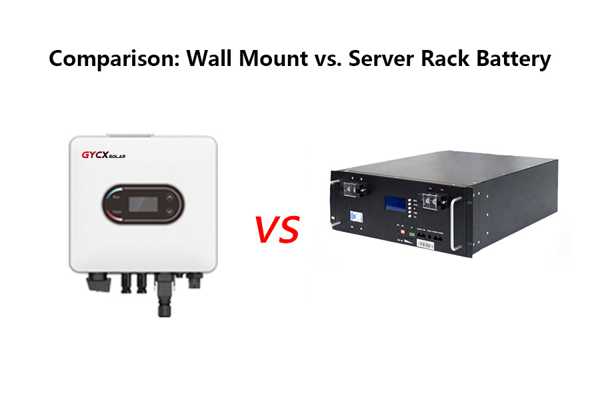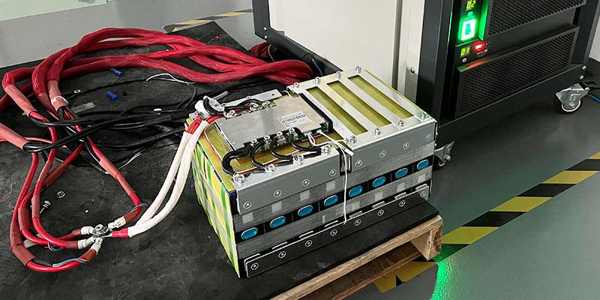什么是机架电池?
探索太阳能存储或强大的备用电源系统时, 您经常会遇到“机架电池”一词" 或“机架安装的电池”。" 这到底是什么, 为什么这是专业和高容量设备的流行选择? 让我们揭开这种功能强大且可扩展的储能解决方案.
机架电池是锂离子电池模块, 通常使用安全耐用的LFP (铁磷酸锂) 化学, 这是由标准化的19英寸宽度构建的. 这种特定的设计允许它牢固地安装或“机架”" 进入标准设备柜或机架. 这些模块是高密度的构建块, 有组织, 易于扩展的能源存储系统, 形成许多现代贝斯的核心 (电池储能系统) 解决方案.

在 吉克斯太阳能, 我们经常使用 机架安装的锂电池 因为它们提供了令人难以置信的灵活性和功率密度. 它们使我们能够为客户建立一个非常尺寸的能源解决方案, 从大型房屋到商业企业. 让我们探讨它们的工作方式以及与其他选择的比较.
哪个更好的服务器架或壁挂电池?
这是选择家庭或商务电池系统时最常见的问题之一. 你有光滑的, 像设备一样的壁挂单元,工业越多, 模块化服务器架电池. 哪一个是“更好" 为您选择?
普遍“更好”; 最佳选择完全取决于您的特定需求, 特别 可扩展性和美学. 壁挂电池 通常“更好" 对于那些优先级时尚的人, 多合一设计并有标准的储能需求. 服务器架电池 “更好" 对于那些需要更大的人, 高度可扩展, 或更多定制系统, 在更高的能力下,提供更大的灵活性,通常每千瓦时更高的价值.

深入潜水: 选择电池形式
让我们分解每个人的利弊,以帮助您决定:
壁挂电池系统 (例如, 特斯拉Powerwall, Enphase IQ电池):
- 最好的: 想要特定的房主, 共同的能力 (例如, 10-14 千瓦时), 重视干净, 设备般的美学, 喜欢单品牌, 集成解决方案.
- 优点:
- 美学: 设计为在车库或杂物间墙壁上看起来不错.
- 简单: 通常是一个包装的多合一包装, 电池管理系统, 有时是它自己的逆变器.
- 品牌生态系统: 如果您已经使用了同一品牌的其他产品,可以提供无缝操作.
- 缺点:
- 较低的可扩展性: 虽然您可以添加更多单元, 通常很大, 固定增量 (例如, 添加另一个 13.5 kWh单位).
- 所有权: 有时可以将您锁定到特定制造商的硬件和软件生态系统中.
服务器架电池系统 (例如, 来自Growatt等品牌的模块化LFP电池, 派隆科技, EG4):
- 最好的: 能量高需求的用户, 那些期待未来扩张的人, 离网申请, 或任何想要最大的灵活性和控制系统组件的人.
- 优点:
- 高度可扩展: 您可以轻松添加较小的内存模块 (通常〜5kWh) 准确地满足您的需求并随着时间的推移而扩展. 建造20kWh, 30千瓦时, 或更大的系统很简单.
- 灵活性: 许多机架电池都使用开放通信协议, 允许它们与更广泛的高质量第三方混合逆变器配对.
- 成本效益的规模: 建造较大的电池库时,通常会提供较低的每千瓦时成本.
- 高密度: 将大量能量包装到紧凑的架子足迹中.
- 缺点:
- 美学/空间: 需要专用 (但是紧凑) 落地橱柜或架子, 具有更具工业外观.
GYCX太阳能故事: “我们每天指导客户进行此选择. 对于新加坡的公寓老板,空间有限,渴望清洁的外观, 一个壁挂单元很完美. 对于需要40kWh存储的企业主, 一个带我们八个可堆叠架电池的机柜更可扩展和成本效益。"
锂电池必须安装平坦吗?
源于旧电池规则的一个常见问题是现代锂电池是否具有严格的安装方向要求. 他们总是必须放平?
不, 现代密封的锂离子电池不必平坦. 多亏了他们的内部构造, 其中没有自由流动的液体电解质, 它们几乎可以安装在任何方向上 - 平坦 (水平), 在他们的身边, 或直立 (垂直). 这种设计自由正是能够创建多功能形式的原因 壁挂式 单位和紧凑 架子电池.

深入潜水: 免受液体电解质的自由
“必须直立" 规则是传统洪水酸酸电池的保留, 含有液体硫酸,如果倾倒了. 现代锂电池, 特别是 磷酸铁锂1. 我们使用的类型 机架安装的锂电池, 根本不同:
- 通过设计密封: 内部的单元完全密封. 电解质要么是凝胶状物质,要么完全吸收到固体电极之间的分离材料中.
- 固体内部结构: 内部组件已牢固地固定在适当的位置,并且不受其方向相对于重力的影响.
- 实现现代形态: 这种灵活性使制造商可以设计…
- 壁挂电池: 垂直安装以节省地板空间.
- 架子电池: 水平安装 (滑入架子) 达到高密度.
虽然他们是位置不可能的, 您应始终咨询制造商的安装手册. 在某些特定设计中, 可能有一个 首选 方向以优化气流优化冷却鳍, 但功能上, 他们在任何位置安全运作. 这种多功能性使我们可以在GYCX太阳能设计适合客户独特空间的令人难以置信的清洁和空间效率的系统.
在哪里保持锂电池的最佳场所?
您选择了电池系统, 但是到底应该在哪里安装? 该位置与电池本身一样重要,以确保安全, 表现, 和寿命很长.
保持锂电池的最佳场所是 凉爽的, 干燥, 且通风良好的位置可保护免受直射和物理伤害. 用于家庭或企业存储系统, 这通常意味着车库, 专用的杂物间, 或室内壁橱. 专业的外壳, 像 电池架或橱柜, 提供理想的安全和有条理的环境.

深入潜水: 为电池创造完美的环境
这是理想电池存储位置的清单:
- 凉爽的: 热量是电池寿命的主要敌人. 在像新加坡一样炎热潮湿的气候中, 至关重要的是要避免在捕获加热的地方安装电池, 像未通风的棚子或暴露于直接下午阳光的区域. 理想的环境温度通常约为20-25°C (68-77°f).
- 干燥: 将电池远离任何潜在的水分或洪水来源以保护其电子组件 (像BMS) 以及腐蚀和损坏的终端.
- 通风: 虽然LFP电池在正常运行期间不会产生易燃气体, 他们确实产生了一些热量. 良好的通风或气流对于热管理至关重要,以使这种热量消散, 保持细胞冷却并确保长寿. 这就是为什么我们的电池架和橱柜旨在促进气流的原因.
- 安全和保护: 该位置应保护电池系统免受意外物理影响, 篡改, 或与其他物品混乱. 作为一般消防安全预防措施,它也应远离任何易燃材料.
- 可访问 (服务): 虽然您不需要对密封的锂电池进行定期维护, 该系统应可以通过合格的技术人员进行初始安装和任何潜在的未来服务访问.
专用 机架电池 内阁旨在满足所有这些标准, 提供安全, 有组织, 并为您的储能系统通风.
是什么毁了锂电池?
为了充分利用您在锂电池系统中的大量投资, 知道什么会导致它过早失败是至关重要的. 哪些常见的罪魁祸首会破坏锂电池?
破坏锂电池的主要因素是 暴露于高温, 充电不当 (专门充电或使用不兼容的充电器), 允许它留在 完全排放的状态 长期, 当然, 物理伤害 就像被刺穿或粉碎. 幸运的是, 高质量的贝斯 (电池储能系统) 有一个精致的 电池管理系统 (电池管理系统) 旨在保护电池免受大多数这些电力故障模式的影响.

深入潜水: 保护电池投资
这是现代系统的方式, 喜欢 机架安装的锂电池 来自GYCX太阳能, 受到这些普通杀手的保护:
- 热量过多: 如前所述, 热加速化学降解.
- 解决方案: 适当安装在凉爽, 通风位置. BMS还监视温度,如果太热,则将油门或关闭系统关闭, 防止灾难性失败.
- 充电不当: 过度充电锂电池极为危险且有害.
- 解决方案: 优质的BES包括BMS和兼容的电荷控制器 (通常是混合逆变器的一部分) 那共同起作用. 他们使用精确的充电算法,并在电池填充时自动停止充电. 这使得在专业安装的系统中过度收费.
- 深度排放到零: 将电池留在 0% 可能造成不可逆转的损害.
- 解决方案: BMS通过低压截止. 它将自动断开电池的连接,而仍然很小, 剩下的安全量, 防止深层排放.
- 身体伤害: 刺穿锂离子电池会引起短路和火.
- 解决方案: 这就是为什么稳健的围栏是必不可少的. 我们的 机架电池 模块安装在坚固的金属套管中, 然后将其安装在保护柜中, 屏蔽他们免受意外撞击.
GYCX太阳能故事: “我们始终强调,'电池'只是''系统的一部分。系统 - BMS, 逆变器, 架子, 适当的安装 - 是保护电池并使其安全的原因, 长期资产. 那完整, 工程解决方案是我们提供的。"
了解什么是机架电池以及与其他形式的比较,例如壁挂装置的单元,这是选择正确的储能解决方案的关键. 机架电池提供无与伦比的可伸缩性和灵活性, 建立在安全,持久的LFP锂技术的基础上. 通过知道如何正确存储和照顾电池系统, 您可以确保获得数十年的可靠, 清洁能源.
如果您对我们的专业机架电池解决方案有疑问,或者想找出哪种系统类型最适合您的家庭或企业, GYCX太阳能团队在这里提供专家指导. 立即与我们联系以进行咨询!
了解LFP的概念将帮助您更好地比较和理解与电池相关的数据概念. 这将帮助您选择最适合我们公司需求的产品. ↩
